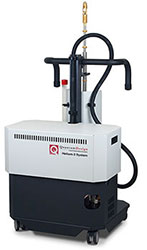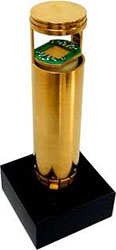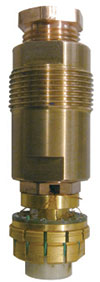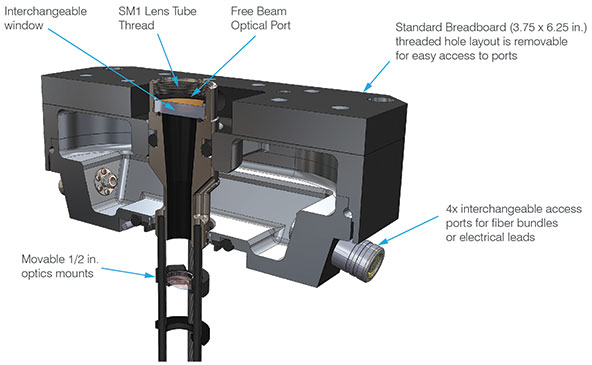get a quote
Cryogen-Free Option Available Now! The Quantum Design PPMS EverCool-II® is an exciting cryogen-free enhancement to our industry-leading Physical Property Measurement System (PPMS) product line. Available in new systems, or as an upgrade to your existing PPMS.
Features
• Sealed sample chamber with 2.6 cm diameter sample access.
• EverCool-II cryogen-free cooling technology.
• Versatile sample mounts couple easily to the 12 electrical leads built into the cryostat insert.
• The PPMS is controlled by the Model 6000, a sophisticated microprocessor-controlled device that eliminates the need to use or purchase external bridges, current or voltage sources, or lock-in amplifiers. • Continuous Low-Temperature Control – maintains temperature below 4.2 K and offers smooth temperature transitions when warming and cooling through 4.2 K.
• Temperature Sweep Mode.
• User Experiments – External instruments may be controlled automatically using an integrated Visual Basic interface within our Windows-based MultiVu control software or by controlling external Visual C++, Delphi or Visual Basic programs. Click here for more details. In addition, our Grapher utility displays data as it is being collected.
Options
• Select from 7, 9, 14 and 16 tesla magnets.
• Or order a system with no magnet and add a magnet when needed.
• A split-coil 7 tesla transverse magnet is also available.
Physical Property Measurement System - PPMS®
Quantum Design
The Quantum Design PPMS represents a unique concept in laboratory equipment: an open architecture, variable temperature-field system, designed to perform a variety of automated measurements. Use the PPMS with our specially-designed measurement options, or easily adapt it to your own experiments. Sample environment controls include fields up to ±16 tesla and temperature range of 1.9 - 400 K. Its advanced expandable design combines many features in one instrument to make the PPMS the most versatile system of its kind.Cryogen-Free Option Available Now! The Quantum Design PPMS EverCool-II® is an exciting cryogen-free enhancement to our industry-leading Physical Property Measurement System (PPMS) product line. Available in new systems, or as an upgrade to your existing PPMS.
Features
• Sealed sample chamber with 2.6 cm diameter sample access.
• EverCool-II cryogen-free cooling technology.
• Versatile sample mounts couple easily to the 12 electrical leads built into the cryostat insert.
• The PPMS is controlled by the Model 6000, a sophisticated microprocessor-controlled device that eliminates the need to use or purchase external bridges, current or voltage sources, or lock-in amplifiers. • Continuous Low-Temperature Control – maintains temperature below 4.2 K and offers smooth temperature transitions when warming and cooling through 4.2 K.
• Temperature Sweep Mode.
• User Experiments – External instruments may be controlled automatically using an integrated Visual Basic interface within our Windows-based MultiVu control software or by controlling external Visual C++, Delphi or Visual Basic programs. Click here for more details. In addition, our Grapher utility displays data as it is being collected.
Options
• Select from 7, 9, 14 and 16 tesla magnets.
• Or order a system with no magnet and add a magnet when needed.
• A split-coil 7 tesla transverse magnet is also available.
Temperature Stages
Low Temperature Stages Measurement Options:Helium-3 Refrigerator
• Continuous operation down to 0.5 K
• Compatible with Heat Capacity, Electrical Transport and DC Resistivity measurements

Dilution Refrigerator
• Continuous operation from 4 K down to 50 mK
• Compatible with Heat Capacity, AC Susceptibility for DR, and Electrical Transport measurements
Adiabatic Demagnetization Refrigerator (ADR)

• World’s fastest
Thermal Measurement
Thermal Measurement OptionsHeat Capacity
• Completely automated relaxation technique from 1.8 - 400 K
• Integrated data acquisition electronics and analysis software
Thermal Transport
AC Resistivity ρ
• Measured by using precision DSP current source and phase-sensitive voltage detection.
Thermal Conductivity κ
• Measured by applying heat from the heater shoe in order to create a user-specified temperature differential between the two thermometer shoes.
Seebeck Coefficient α
• Measured by creating a specified temperature drop between the two thermometer shoes - just as it does to measure thermal conductivity. However, for Seebeck coefficient the voltage drop created between the thermometer shoes is also monitored.
Thermoelectric Figure of Merit ZT
• Determined here simply as the algebraic combination α2T /(κρ) of the three measured quantities - thermal conductivity, Seebeck coefficient, and AC electrical resistivity.
Magnetometry
Magnetometry Measurement OptionsVibrating Sample Magnetometer (VSM)
• RMS Sensitivity: < 10-6 emu with 1 sec averaging
• Optional VSM Oven up to 1000 K
Torque Magnetometry
• Measures the magnetic torque = mBsinθ
• Designed to measure moments of very small anisotropic samples
• Moment Sensitivity: 1 x 10-7 emu at 9T; 1 x 10-8 emu at 14T
AC Susceptibility (ACMS II)
• AC Susceptibility
• Sensitivity: 1 x 10-8 emu
• Amplitude: 0.005 Oe – 15 Oe (peak)
• Frequency Range: 10 Hz – 10 KHz
• Direct phase nulling technique measures and cancels background AC phase shifts at every measurement
• DC Magnetization
• Sensitivity: 5 x 10-6 emu
AC Susceptibility for DR (ACDR)

• AC Susceptibility
• Drive Amplitude: 0.002 Oe – 4 Oe (peak)
• Sensitivity: 5x10-7 emu
• Phase Accuracy: 2°
• Frequency Range: 10 Hz to 10 kHz
• DC Field Range
• Up to ±12T
• Temperature Range
• 50mK – 4K
Ultra Low Field (ULF)
• Reduces residual field to < 0.1 G
Magneto-Optic
Sample Rods:
• Choice of UV or IR Rod
•UV >90% transmittance 325 nm - 900 nm
•IR >90% transmittance 375 nm - 2250 nm
• Sample holder volume 2.68 mm3
• Moment Sensitivity
Electro-Transport
Electric-Transport Measurement OptionsDC Resistivity
• Four independent channels for performing DC resistivity
• Temperature Range: Down to 500 mK with He3 Option
• Current Range: 2 nA to 8 mA
• Sample Resistance Range: Up to 5 MOhm
Electrical Transport (ETO)
• For performing AC Resistance, Hall Effect, I-V, and Differential Resistance (dV/dI vs. I) measurements.
• 1nV sensitivity, 10 nΩ resolution at 100 mA
• AC and DC drive amplitude 10 nA to 100 mA
• Resistance ranges from 10 µΩ to 5 GΩ
Horizontal Sample Rotator
• Thermometer located on rotator platform
• Precision, stepper controlled rotator
• Step Size: 0.013 degrees (standard); 0.0011 degrees (high resolution)
• Angle Range: -10 degrees to 370 degrees
Multi-Function Probe
• Direct axial ports to the sample stage are provided to install light pipes, fiber optic cables, microwave guides and/or extra electrical leads
Microscopy
Microscopy Measurement Options
Quantum Design and Attocube Systems announced the PPMS SPM – the only Scanning Probe Microscopes certified and endorsed by Quantum Design for use in its respected Physical Property Measurement System (PPMS). The ultra-compact, high resolution PPMS SPM uses advanced technologies such as low temperature compatible objectives for confocal microscopy or a fiber-optical interferometer for force microscopy with outstanding signal-to-noise force detection.
The rugged housing construction is made from highest quality Titanium, ensuring maximum stability and minimum sample drift during variation of temperature and/or magnetic field. The patented driving technology of the coarse positioning system warrants a precise and reliable sample approach and positioning in three axes with nanometer precision over several millimeters range. Plus, the instrument is fully compatible with commercially available AFM/MFM cantilevers.
PPMS SPM Features
• Unrivaled performance in the PPMS environment
• Robust mechanical and electrical design
• Compatible with the PPMS operating range
•Temperature: 1.9 K – 400 K
•Field: ± 16 T
• Patented positioner technology
• MFM resolution: Below 20 nm
• Positioning range: 3 × 3 mm
• Scanning range: 12 × 12 μm2
Microscopy Options
• Low Temperature Magnetic Force Microscope (attoMFM Ixs): ultra-compact magnetic force microscope designed particularly for applications at low and ultra low temperature. On the basis of a conventional atomic force microscope, the instrument works by scanning a sample below a fixed magnetic cantilever. The magnetic force gradient acting on the tip is then determined by measuring the change in resonance frequency (FM mode) or phase of the cantilever (AM mode) with highest precision using a fiber-based optical interferometer.
• Low Temperature Atomic Force Microscope (attoAFM Ixs): ultra-compact atomic force microscope designed particularly for applications at low and ultra low temperature. The instrument works by scanning a sample below a fixed cantilever while measuring its deflection with the highest precision using a fiber based optical interferometer. Combined with the ASC500 SPM controller, both contact and noncontact modes are applicable, making the attoAFM Ixs a powerful tool for topographic measurements, force spectroscopy and other imaging modes.
• Low Temperature Scanning Hall Probe Microscope (attoSHPM xs): ultra-compact scanning Hall probe microscope, designed particularly for operation at low temperature and high magnetic fields. At the heart of the SHPM, a molecular beam epitaxy (MBE) grown GaAs/AlGaAs Hall sensor measures magnetic fields with unrivaled sensitivity. Local measurements of the magnetization of a sample are obtained by scanning the sample underneath the Hall sensor and simultaneously recording the Hall voltage, directly yielding the local magnetic field.
• Low Temperature Confocal Microscope (attoCFM xs): ultra-compact confocal microscope developed to offer the highest flexibility combined with maximum mechanical stability for low temperature confocal microscopy experiments. Can be ordered with either free-beam or fiber based optics. With free-beam optics, excitation and collection ports are completely independent, allowing the introduction of further optical components (e.g. filter or polarizer) and enabling measurements such as Raman spectroscopy. The fiber based setup is designed for the highest mechanical stability, allowing single quantum dot measurements over a time span of several weeks and operation in cryogen-free cryostats.

High Pressure
High Pressure Cell for MagnetometryIntroducing a novel, high pressure cell for magnetometry that allows easier sample insertion and removal without the need of an hydraulic press. This pressure cell, manufactured by HMD, comes in a complete kit that contains all the accessories you will need to aid in the characterization of your samples.


Benefits of the HMD Pressure Cell:
• All BeCu design for more uniform magnetic background
• No copper ring seal ensures easy sample removal
• All necessary accessories conveniently packaged
• Compatible with VSM transport
• No hydraulic press necessary
Specifications:
• Maximum Applied Pressure – 1.3 GPa
• Sample Space Diameter – 1.7 or 2.2 mm
• Sample Space Length – 7 mm max
• Cell Diameter – 8.5 mm
• Temperature Range – 1.8 to 400K
** Please Note: Requires VSM and Large Bore Coil Set **
Hydrostatic Pressure Cell for Electrical Measurements
Introducing a hydrostatic pressure cell for electrical measurements designed for use in all PPMS platform instruments (PPMS, DynaCool, VersaLab) . This pressure cell, manufactured by ElectroLab, is compatible with Quantum Design’s DC Resistivity, ACT and ETO measurement options.

Benefits of the ElectroLab Pressure Cell:
• Based on BeCu pressure cell technology
• Integrated external thermometer
• 10 sample leads (5 twisted pairs)
• Compatible with all QD PPMS platforms
• Manufactured by the leading supplier of hydrostatic pressure cells in Japan
• Several press sets also available
Specifications:
• Maximum Applied Load – 3.0 GPa
• Maximum Sample Pressure – 2.7 GPa
• Sample Space Diameter – 4.0 mm
• Sample Space Length – 6.0 mm max
• Temperature Range – 1.9 to 400K
Spectroscopy
Spectroscopy Measurement OptionsNanOsc FMR Spectrometers

The CryoFMR spectrometer is a plug and play system that allows broadband CPW-FMR characterization with lock-in capability. It includes its own RF frequency source as well as lock-in detection module, so that the only parts required to conduct an experiment are a computer for software control and a PPMS platform. Temperature range: 4 K to 400 K. Frequency Range 2 to 17 GHz.
Expansion
Expansion Measurement OptionsDilatometer

Measures relative expansion (dilation) and first derivative (coefficient of expansion) with respect to temperature and field, with sub-angstrom sensitivity. This is accomplished using a differential ratiometric capacitance bridge, operating at 2.340 kHz, which offers high sensitivity and dynamic range.
Optics
OpticsOptical Multi-Function Probe (OMFP)
The newly designed Optical Multi-Function Probe (OMFP) offers unprecedented flexibility and versatility that allows you to conduct photonic, quantum optics and correlative microscopy experiments within the variable temperature and magnetic field environments of the PPMS, DynaCool and VersaLab. The OMFP probe features a room temperature “head” with multiple access ports and integrated optical breadboard for mounting optical components such as spherical and achromatic lenses, turning mirrors, filters, diffusers, beam splitters, prisms, waveplates, fiber bundles and electrical wiring. The open modular design of the probe head provides easy access to the axial ports and connectors which can be configured to route electrical, single fibers, fiber bundles and miniature waveguides to the sample space. In addition, a central optical access port allows free-beam optics experiments in the cryostat. A 0.5 in. standard optical thread mount makes aligning and focusing lens assemblies fast and easy.

Features
• Available for VersaLab, DynaCool and PPMS
• Half inch (SM05) free-beam access port for optical capability along optical path
• Direct axial electrical, SMA and other ports to sample stage provided to install light pipes, fiber optics cables, and/or electrical leads
• 2 sets of 4 electrical leads on sample PCB interface for electrical transport experiments
• Multiple measurement capability (e.g., electrical resistivity, Hall effect, Van der Pauw, magnetometry and other optical measurements)
• Integrated wiring for optional motorized Cartesian positioning system (3 x 3 x 3 mm movement capability)
• Sample stage with integrated thermometer
• Multi-Position filter and lens mounts for cold region of probe
• 300 K to 50 K, ± 3 T (VersaLab); 300 K to 1.8 K, ± 14 T (DynaCool); 300 K to 1.9 K, ± 16 T (PPMS)
Applications
• Free optics studies
• Fiber optics measurements
• Thermal-Optical properties
• Magneto-Optical properties
Cartesian Positioning System

A fully motorized Cartesian sample positioning system can be used with our Optical Multi-Function Probe (OMFP) to focus a laser beam or other excitation source on a particular region of the sample. The Cartesian positioning system provides for an XYZ movement capability of 3 x 3 x 3 mm.
Xenon Light Source

• Choice of 150 W or 300 W light source
• Xenon Arc Lamp
• 10 position filter wheel
• 9 bandpass filters (436 nm, 470 nm, 500 nm, 530 nm, 555 nm, 585 nm, 640 nm, 740 nm, 850 nm)
PDFs
- Applications of Superconducting Magnetic Separation
- ATL80 Direct Recovery System
- ATL in NMR
- Enhancement of the Liquefaction Rate in Small-Scale Helium Liquefiers
- EUCAS Poster - SHGMS Results for Kaolin Clay
- High Pressure Recovery System
- High Pressure Cell for Magnetometry
- Hydrogen-Free Liquid-Helium Recovery Plants The Solution for Low-Temperature Flow Impedance Blocking
- iQuantum He3 for MPMS3
- MEG Direct Recovery System








